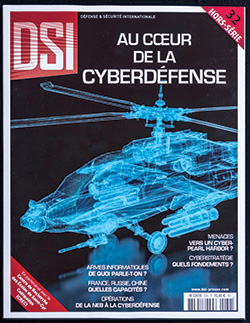JOURNAL REVIEW ESSAY

DND photo KN2014-070-003
Situational Awareness Depends upon Intelligence Gathering, but Good Preparation Depends upon Knowledge of the Issues
by Sylvain Chalifour
For more information on accessing this file, please visit our help page.
We all have very busy schedules. Nevertheless, it is essential to stay informed about the world around us, especially issues related to defence, international security, and world politics. To that end, allow me to introduce my latest discovery: Areion Group, a French publishing company that specializes in geopolitics and defence, and produces eight monthly and bi-monthly journals that are relevant to anyone in the profession of arms.
Each bi-monthly special issue of Défense et sécurité internationale (DSI) focuses upon a specific military theme. Recent special issues have covered the US Navy, land combat, the Arctic as a strategic issue, the revival of naval warfare, warfare in space, fighter aircraft, and artillery and its future. Each special issue consists of about 100 pages (depending upon the subject) in which civilian and military specialists write about military supply systems, inventories, trends, directions for military or strategic resources, and so on – situation reports on a world that is constantly changing.
For example, the theme of Special Issue 32 of DSI is cyber warfare. In the first section of the issue, cyber security and cyber defence researchers define cyberspace and the adversaries that could navigate there. Like me, you may be asking yourself whether this represents a revolution in the military world. Would defining the paradoxes of cyber warfare help answer that question? Would you like to learn more about what capabilities for action are already in place and whether there is asymmetry in cyber warfare? What issues concerning cyberspace are at the heart of international geopolitical tensions, and what are the roles played by Iran, China, North Korea, Russia, and the United States? Our American neighbours cite a cyber–Pearl Harbor as an example of a threat; it is easy to imagine to what they are referring. But what is the likelihood of such a disaster occurring in the short term? Have you ever heard of the Stuxnet virus? The authors describe that real-life example of a cyber attack in detail, noting that the virus was developed by the Israelis and the Americans to stop Iran’s heavy water production program. Would you like to know how the virus was spread, how it infected a high-security research facility, and what were the results of the attack? These are, of course, important questions – but would it not be better to think about how to defend ourselves if such an attack was mounted against our own systems?

DND photo KN2014-070-001
And indeed, the second section of this DSI Special Issue presents possible solutions to threats in cyberspace, answering questions such as the following: What are the national and international legal frameworks for cyberspace? Is there an ethics governing the use of force in cyberspace? What are the major trends in national cyber security strategies? What is the French doctrine on cyber warfare? China is talking about cyber defence, Russia is talking about cyber strategic power–so where is the United States in terms of cyber tactics? The articles in this issue present the unvarnished reality, backed up by a solid reference list. The bibliographic references in French and English alone are worth their weight in gold. You may also be interested in Areion Group publications in other fields, such as geography, international politics, cartography, and sociology.
I would also like to take this opportunity to mention another impressive publication, the monthly journal Diplomatie, whose bimonthly special issues are also relevant to us.
In a format similar to that of DSI, each special issue of Diplomatie is 100 pages in length and presents an in-depth exploration of a particular subject likely to be of interest to military readers. For example, several have focused upon a particular world power: the United States, Russia, India, and Brazil. Each of those special editions delves into the history of the country, its political situation, the functioning of government, the country’s strategic issues, its military and economic power, and so on. Others feature global issues such as space, the geopolitics of water, different forms of trafficking, nuclear power, conflicts around the world, and economic espionage.
Take, for example, the special issue dealing with the global geopolitics of narcotics trafficking. It contains a wealth of information about the history of the manufacture of illicit substances and the trade in legal and illegal drugs, as well as global positions on these national and regional issues. For example, you’ll find answers to the following questions: At the global level, what are the powers in place? How does the money circulate? How do criminal networks function? How are we combatting drug trafficking? What are the channels in Europe, Africa, Asia and the Americas? Everyone has heard of the cartels. But how are they formed? How do they function? Where are they? How are we combatting them? The Zetas are one of the cruellest cartels in the world. How do they operate with such military-style precision and efficiency? I could say much more about the lobbies and networks and the national influences and international challenges described in this issue, but space does not permit it. If you want to learn more about these two publications, I suggest that you visit the website http://www.geostrategique.com and have a look at the back issues that are available. You are sure to find some fascinating reading on a subject that interests you. But beware: once you start, you may not want to stop.
Major Sylvain Chalifour, CD, is the Public Affairs Officer at the Canadian Defence Academy in Kingston, Ontario.







